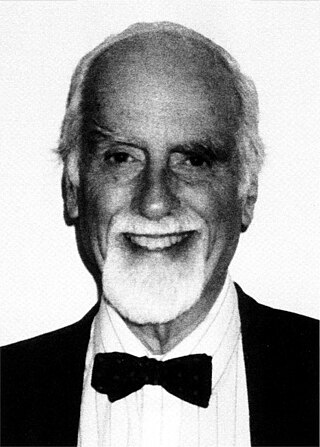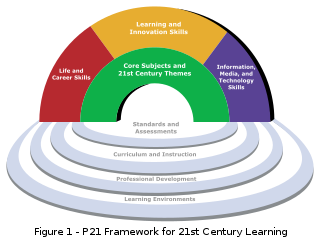Industrial and organizational psychology "focuses the lens of psychological science on a key aspect of human life, namely, their work lives. In general, the goals of I-O psychology are to better understand and optimize the effectiveness, health, and well-being of both individuals and organizations." It is an applied discipline within psychology and is an international profession. I-O psychology is also known as occupational psychology in the United Kingdom, organisational psychology in Australia and New Zealand, and work and organizational (WO) psychology throughout Europe and Brazil. Industrial, work, and organizational (IWO) psychology is the broader, more global term for the science and profession.
Emotional intelligence (EI) is defined as the ability to perceive, use, understand, manage, and handle emotions. People with high emotional intelligence can recognize their own emotions and those of others, use emotional information to guide thinking and behavior, discern between different feelings and label them appropriately, and adjust emotions to adapt to environments.

Training is teaching, or developing in oneself or others, any skills and knowledge or fitness that relate to specific useful competencies. Training has specific goals of improving one's capability, capacity, productivity and performance. It forms the core of apprenticeships and provides the backbone of content at institutes of technology. In addition to the basic training required for a trade, occupation or profession, training may continue beyond initial competence to maintain, upgrade and update skills throughout working life. People within some professions and occupations may refer to this sort of training as professional development. Training also refers to the development of physical fitness related to a specific competence, such as sport, martial arts, military applications and some other occupations.

Teaching is the practice implemented by a teacher aimed at transmitting skills to a learner, a student, or any other audience in the context of an educational institution. Teaching is closely related to learning, the student's activity of appropriating this knowledge.
A core competency is a concept in management theory introduced by C. K. Prahalad and Gary Hamel. It can be defined as "a harmonized combination of multiple resources and skills that distinguish a firm in the marketplace" and therefore are the foundation of companies' competitiveness.

An athletic coach is a person coaching in sport, involved in the direction, instruction, and training of a sports team or athlete.
In psychology, self-efficacy is an individual's belief in their capacity to act in the ways necessary to reach specific goals. The concept was originally proposed by the psychologist Albert Bandura in 1977.
Recognition of prior learning (RPL), prior learning assessment (PLA), or prior learning assessment and recognition (PLAR) describes a process used by regulatory bodies, adult learning centres, career development practitioners, military organizations, human resources professionals, employers, training institutions, colleges and universities around the world to evaluate skills and knowledge acquired outside the classroom for the purpose of recognizing competence against a given set of standards, competencies, or learning outcomes. RPL is practiced in many countries for a variety of purposes, for example an individual's standing in a profession, trades qualifications, academic achievement, recruitment, performance management, career and succession planning.
Competence is the set of demonstrable characteristics and skills that enable and improve the efficiency or performance of a job. Competency is a series of knowledge, abilities, skills, experiences and behaviors, which leads to effective performance in an individual's activities. Competency is measurable and can be developed through training.
Emotional competence and emotional capital refer to the essential set of personal and social skills to recognize, interpret, and respond constructively to emotions in oneself and others. The term implies an ease around others and determines one's ability to effectively and successfully lead and express.
Cultural competence, also known as intercultural competence, is a range of cognitive, affective, behavioural, and linguistic skills that lead to effective and appropriate communication with people of other cultures. Intercultural or cross-cultural education are terms used for the training to achieve cultural competence.
Competencymanagement systems are usually associated with, and may include, a learning management system (LMS). The LMS is typically a web-based tool that allows access to learning resources. Competency Management Systems tend to have a more multidimensional and comprehensive approach and include tools such as competency management, skills-gap analysis, succession planning, as well as competency analysis and profiling. The CompMS tends to focus more on creating an environment of sustainable competency in addition to entering and tracking learning resources in software. However, conceptually, there is no reason why a CompMS or LMS could not be manual and indeed learning management systems are as old as learning institutions.
Richard Eleftherios Boyatzis is a Greek-American organizational theorist and Distinguished University Professor in the Departments of Organizational Behavior, Psychology, and Cognitive Science at Case Western Reserve University, Adjunct Professor in People/Organizations at ESADE, as well as HR Horvitz Professor of Family Business. He is considered an expert in the field of emotional intelligence, behavior change, and competence.

David Clarence McClelland was an American psychologist, noted for his work on motivation Need Theory. He published a number of works between the 1950s and the 1990s and developed new scoring systems for the Thematic Apperception Test (TAT) and its descendants. McClelland is credited with developing Achievement Motivation Theory, commonly referred to as "need for achievement" or n-achievement theory. A Review of General Psychology survey published in 2002, ranked McClelland as the 15th most cited psychologist of the 20th century.
Life skills are abilities for adaptive and positive behavior that enable humans to deal effectively with the demands and challenges of life. This concept is also termed as psychosocial competency. The subject varies greatly depending on social norms and community expectations but skills that function for well-being and aid individuals to develop into active and productive members of their communities are considered as life skills.
Capability management is the approach to the management of an organization, typically a business organization or firm, based on the "theory of the firm" as a collection of capabilities that may be exercised to earn revenues in the marketplace and compete with other firms in the industry. Capability management seeks to manage the stock of capabilities within the firm to ensure its position in the industry and its ongoing profitability and survival.
Cross-cultural psychology attempts to understand how individuals of different cultures interact with each other. Along these lines, cross-cultural leadership has developed as a way to understand leaders who work in the newly globalized market. Today's international organizations require leaders who can adjust to different environments quickly and work with partners and employees of other cultures. It cannot be assumed that a manager who is successful in one country will be successful in another.
Leader development is defined as the "expansion of a person's capacity to be effective in leadership roles and processes". These roles and processes are ones that aid in setting direction, creating alignment and maintaining commitment in groups of people sharing common work. Most organizational leadership research and educational programs have focused on developing individual-based knowledge, skills, and abilities associated with formal leadership roles of individuals. Leader development therefore results by investing in human capital.
Social competence consists of social, emotional, cognitive, and behavioral skills needed for successful social adaptation. Social competence also reflects having the ability to take another's perspective concerning a situation, learn from past experiences, and apply that learning to the changes in social interactions.

21st century skills comprise skills, abilities, and learning dispositions identified as requirements for success in 21st century society and workplaces by educators, business leaders, academics, and governmental agencies. This is part of an international movement focusing on the skills required for students to prepare for workplace success in a rapidly changing, digital society. Many of these skills are associated with deeper learning, which is based on mastering skills such as analytic reasoning, complex problem solving, and teamwork, which differ from traditional academic skills as these are not content knowledge-based.





